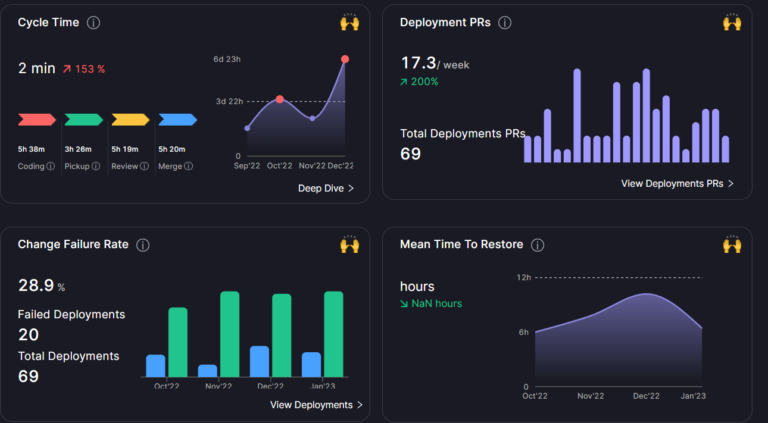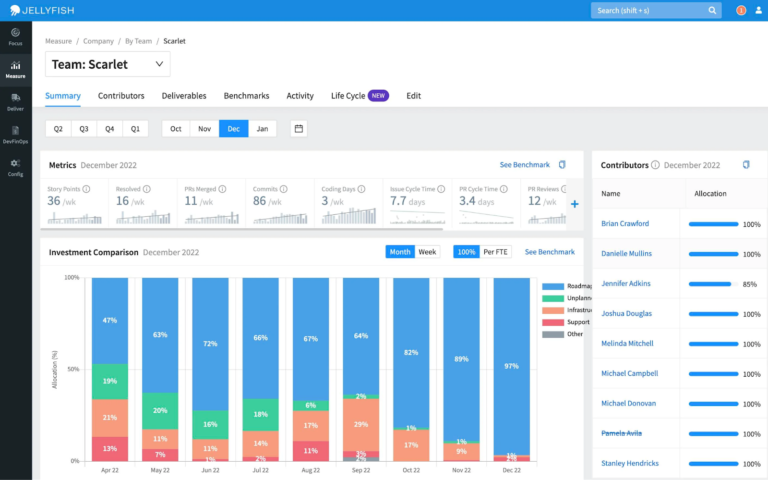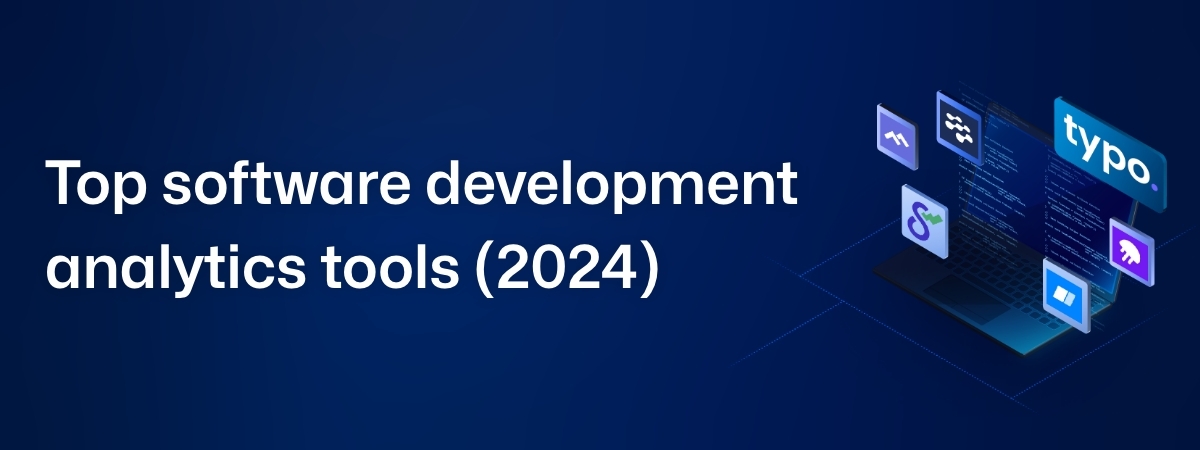The demand for software development analytics tools is on the rise. The organizations aren’t just focusing on outcomes now, they want to get in-depth insights into teams’ health and progress. These tools measure the effectiveness and productivity of the team by turning data into actionable insights.
There are many software development analytics platforms available in the market. We’ve listed out the top 6 tools that you can choose from:
What are software development analytics tools?
Also known as an engineering management platform. These tools help engineering leaders and CTOs track team progress and health by combining various developer performance metrics, at a single place.
These software engineering analytics tools help gain visibility into the time spent on tasks, predict the time taken to complete the task, and report bugs and issues at an early stage. Hence, allowing organizations to make informed decisions, improve performance, and stay on schedule.
Why are software development analytics tools necessary?
The software development industry is evolving. Engineering teams must stay updated with industry trends and best practices to deliver high-quality software to end-users. While meeting deadlines remains a crucial measure of a team’s performance and progress, it’s no longer the sole focus. Today, considerations extend to developers’ well-being and productivity that were usually overlooked earlier.
The organizations aren’t relying solely on DORA metrics now. They are combining it with other engineering metrics as well such as code churn, PR size, rework rate, and more to get in-depth insights into developers’ experience and performance. These software analytics tools consider both qualitative and quantitative aspects to evaluate developer success and gauge their burnout levels. This holistic approach enables engineering leaders to pinpoint bottlenecks, make informed decisions, and foster continuous improvement within their organizations.
Best software development analytics tools
Below are the top 6 software development analytics tools available in the market:
Typo is an effective software engineering intelligence platform that offers SDLC visibility, developer insights, and workflow automation to build better programs faster. It can seamlessly integrate into tech tool stacks such as GIT versioning, issue tracker, and CI/CD tools. It also offers comprehensive insights into the deployment process through key metrics such as change failure rate, time to build, and deployment frequency. Moreover, its automated code tool helps identify issues in the code and auto-fixes them before you merge to master.
Features
- Offers customized DORA metrics and other engineering metrics that can be configured in a single dashboard.
- Includes effective sprint analysis feature that tracks and analyzes the team’s progress throughout a sprint.
- Provides 360 views of the developer experience i.e. captures qualitative insights and provides an in-depth view of the real issues.
- Offers engineering benchmark to compare the team’s results across industries.
- User-friendly interface.

Jellyfish is a GIT-tracking tool that tracks metrics by aligning engineering insights with business properties. It gives a complete insight into the product from Github and Jira which further helps to decide what business value it provides. It also shows the status of every pull request and commits on the team. As a result, it provides full visibility into how engineering work fits in with your business objectives. Jellyfish can also be integrated with Bitbucket, Gitlab, and Google Sheets. However, it lacks user configuration for creating custom supports and UI can be tricky initially.
Features
- Offers multiple perspectives on resource allocation.
- Real-time visibility into engineering organization and team progress.
- Provides you access to benchmarking data on engineering metrics such as lead time and MTTR against industry standards and best practices.
- Includes DevOps metrics for continuous delivery.
- Transforms data into reports and insights for both management and leadership.

Swarmia is a well-known engineering analytics platform that gives engineering leaders and teams visibility across three crucial areas: Business outcomes, developer productivity, and developer experience. Its automation capabilities and SOC 2 certification increase the speed of the tasks without compromising on the product’s quality or developers’ well-being. Swarmia can be integrated with tools such as source code hosting, issue trackers, and chat systems. However, Swarmia lacks integrated benchmarks, making it challenging to gauge metrics against industry standards.
Features
- Its investment balance feature gives insights into the purpose of each action and money spent by the company on each category.
- Offers user-friendly dashboard.
- Its work agreement features include 20+ work agreements that are used by the industry’s top-performing teams.
- Tracks healthy software engineering measures such as DORA metrics.
- Reliable and prompt in-app customer support.

LinearB is a real-time performance analysis tool that measures GIT data and meets business goals. It breaks different tasks into unique categories to refine reports and track individual or team performance. Besides this, LinearB can be integrated with Slack, JIRA, and popular CI/CD tools into testing and deployment metrics which helps to monitor the team’s progress in real-time. It also points out automatable tasks to the engineering teams that help in saving time and resources. The downside of LinearB is there are limited features to support SPACE framework metrics and individual performance insights.
Features
- Tracks DORA metrics and collects data from other tools to give holistic insights.
- Offers reliable customer support.
- Includes engineering benchmarks to stay ahead of the trends and keep up with industry standards.
- Includes playbooks, guides, and presentation templates to present data and take actionable steps.
- Includes project delivery forecasting to stay on schedule and communicate project delivery status updates.

Waydev is another leading software development analytics platform that puts more emphasis on market-based metrics. It also allows development teams to compare the ROI of specific products which helps to identify which features need improvement or removal. It also gives insights into the cost and progress of deliverables and key initiatives. Moreover, Waydev can be seamlessly integrated with Github, Gitlab, CircleCI, Azure DevOps, and other popular tools. However, this analytics tool is only available at the enterprise level.
Features
- Provides automated insights on metrics related to bug fixes, velocity, and more.
- Easy to digest.
- Allow engineering leaders to see data from different perspectives.
- Creates custom goals, targets, or alerts.
- Offers budgeting reports for engineering leaders.

Code climate velocity is an analytics platform that uses repos to synthesize data and provide in-depth visibility into code quality, code coverage, and security vulnerabilities. It analyses data from GIT repositories and then compresses it into real-time analytics. This tool supports both JIRA and GIT integration, Moreover, it can identify files that are frequently modified, and have poor coverage or maintenance issues. The drawback of Code Climate Velocity is that it includes non-standard metrics such as impact and traceability, they may not align intuitively with standard KPIs or OKRs.
Features
- Offers customized dashboards and trends.
- Compiles data on developer velocity and code quality.
- Provides technical debt assessment and style check in every pull request.
- Provides views to each individual i.e. from day-to-day tasks to long progress.
- Includes real-time risk alerts.

Benefits of software development analytics tools
If you’re still in a dilemma about why you should consider software analytics tools for your organization, below are a few benefits you can reflect on:
Streamline delivery process
These tools offer data-driven insights that can help developers identify areas of improvement and fix them in the early stages. Moreover, these analytics tools allow teams to automate repetitive tasks. Hence, helping in reducing cycle time and ensuring consistent, error-free delivery.
Quality assurance
Software development analytics tools continuously monitor and analyze development metrics and fix bottlenecks as early as possible. These tools can also forecast future quality based on historical data. As a result, allowing teams to deliver more reliable and stable software products and services.
Transparency and accountability
These tools include dashboards and insights that provide stakeholders visibility into project progress, performance metrics, and team contributions. It helps in coordinating work and promoting transparency. Hence, fostering accountability among team members and encouraging collaboration towards common goals.
Lower costs
These analytics tools have automated packages too. This allows the team to cut costs and focus on high-value projects. These analytics platforms also take note of areas of improvement and developers’ needs. Hence, helping in making informed decisions and getting the best out of this investment.
How to pick the right software development analytics tools?
Picking the right analytics is important for the development team. Check out these essential factors below before you make a purchase:
Scalability
Consider how the tool can accommodate the team’s growth and evolving needs. It should handle increasing data volumes and support additional users and projects.
Error detection
Error detection feature must be present in the analytics tool as it helps to improve code maintainability, mean time to recovery, and bug rates.
Security capability
Developer analytics tools must compile with industry standards and regulations regarding security vulnerabilities. It must provide strong control over open-source software and indicate the introduction of malicious code.
Ease of use
These analytics tools must have user-friendly dashboards and an intuitive interface. They should be easy to navigate, configure, and customize according to your team’s preferences.
Integrations
Software development analytics tools must be seamlessly integrated with your tech tools stack such as CI/CD pipeline, version control system, issue tracking tools, etc.
Conclusion
Software development analytics tools play a crucial role in project pipelines and measuring and maximizing developers’ productivity. It allows engineering managers to gain visibility into the team’s performance through user-friendly dashboards and reports.
Select analytics tools that align with your team’s needs and specifications. Make sure they seamlessly integrate with your existing and forthcoming tech tools.
While we’ve curated the top six tools in the market, take the time to conduct thorough research before making a purchase.
All the best! 🙂




